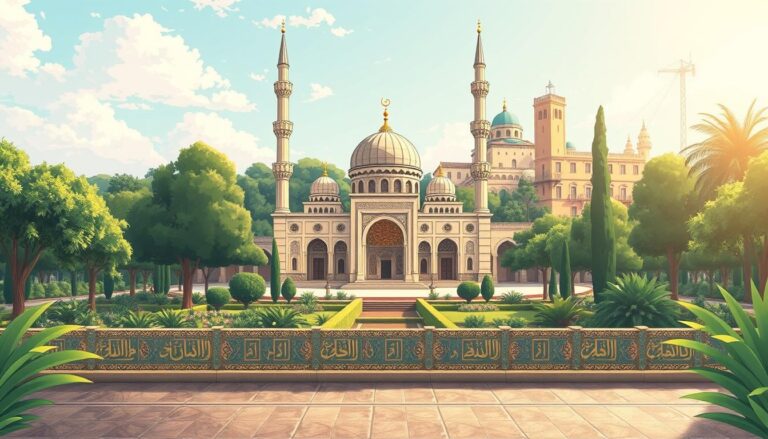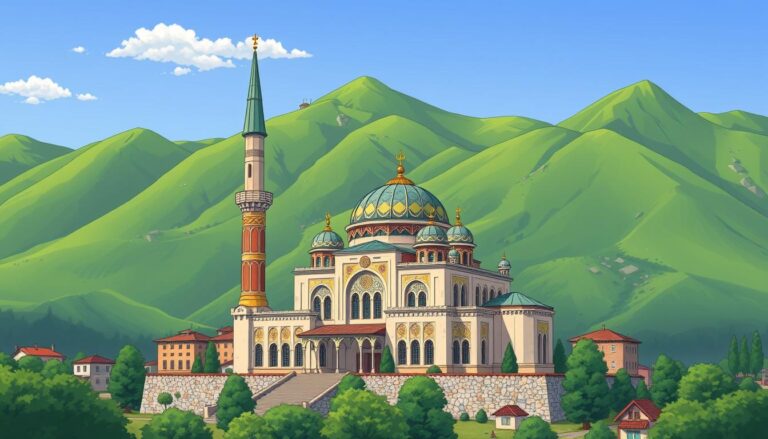Islam in Italy
Contrary to popular belief, the Muslim presence in Italy dates back centuries, with an estimated 2-4% of the population identifying as Muslim today. This minority community has a rich history that spans from the 9th-century Arab colonization of Sicily to the more recent wave of immigration from countries like Pakistan, the Balkans, Bangladesh, India, Morocco, Egypt, and Tunisia. As Italy grapples with the integration of its diverse Islamic population, understanding the intricate past and present of Islam in this European nation becomes increasingly crucial.
Key Takeaways
- The Muslim presence in Italy dates back to the 9th century, particularly in Sicily, where Arab colonization took hold.
- Italy has experienced a recent influx of Muslim immigrants from various countries, including Pakistan, the Balkans, Bangladesh, India, Morocco, Egypt, and Tunisia.
- Islam is not formally recognized by the Italian state, and the Muslim community lacks a unified leadership, with multiple organizations vying to represent different segments of the population.
- Italy has an estimated Muslim population of 2-4%, with Albania and Morocco being the top countries of origin for Muslim immigrants.
- The Italian government has made efforts to integrate the Muslim community, such as the formation of the Consulta per l’Islam Italiano in 2005.
Historical Roots: The First Phase of Islamic Influence
The Islamic history in Italy can be traced back to the early 8th century, when the Umayyad dynasty conquered the Italian island of Pantelleria in 700 AD. This marked the beginning of a long and complex relationship between the Italian peninsula and the Muslim world.
The Arab Conquest of Sicily and Southern Italy
The Arab conquest of Sicily was a significant event in this history. In 827 AD, under the leadership of Asad ibn al-Furat, the Arabs successfully invaded and conquered the island. Over the next few decades, they went on to capture Palermo in 831, Messina in 843, and Syracuse in 878, establishing a strong Muslim rule in southern Italy.
This period of Islamic influence in Sicily and parts of southern Italy lasted until the 12th century, when the Norman conquest of Sicily led to a gradual decline of Islam in the region. Many Muslims either converted to Christianity or emigrated to North Africa.
The Decline of Islamic Rule in the 12th and 13th Centuries
The final blow to the Islamic presence in Italy came in 1245, when Frederick II, the king of Sicily, ordered the deportation of Muslims to the town of Lucera. This was followed by the complete expulsion of Muslims from Italy in 1300, when Giovanni Pipino da Barletta seized Lucera and exiled its population.
Despite this turbulent history, the Islamic influence in Italy had a lasting impact on the country’s culture, architecture, and trade relationships with the Muslim world.
“The Venetians were able to seize architectural references from abroad due to the society being dominated by merchants who had extensive trade networks with the Middle East.”
The Second Wave: Muslim Immigration in Modern Times
The history of Islam’s presence in Italy took a significant turn in the 1980s, as the country began experiencing an unprecedented influx of Muslim immigrants. Prior to this period, Italy was primarily a country of emigration, attracting only small numbers of workers from the Philippines and Latin America in the 1970s. The Muslim population was largely limited to diplomatic personnel, businessmen, and students.
However, in the 1980s, the landscape changed dramatically. Immigrants from North and Sub-Saharan Africa started choosing Italy as their initial or final destination, leading to a substantial increase in the Muslim population. By 2006, estimates suggested that the number of Muslims living in Italy had reached approximately 1 million, accounting for almost 2% of the country’s total population.
This recent Muslim presence in Italy has had a significant impact on the country’s social and cultural fabric. The Muslim immigration to Italy has prompted discussions and debates around issues of integration, religious identity, and the role of Islam in Italian society.
“Nearly half (47%) of recent migrants to Europe have been non-Muslim, with Christians being the next-largest group.”
The influx of Muslim immigrants has also raised concerns within certain segments of the Italian population, leading to the rise of Islamophobic sentiments and the capitalization of these sentiments by right-wing political parties. Navigating the challenges posed by this new wave of immigration has become a critical task for the Italian government and society.
As Italy continues to grapple with the complexities of integrating its growing Muslim population, the role of Islamic institutions, educational practices, and community representation will be crucial in shaping the future of this dynamic and evolving landscape.
Demographics and Diversity of Italy’s Muslim Community
Italy’s Muslim community is characterized by a remarkable diversity in the countries of origin of its members. Unlike many other European nations, Italy’s Muslim population does not have deep historical ties to the country. The two largest groups within the Italian Muslim community are Moroccans (28.5%) and Albanians (20.5%). The remaining Muslims living in Italy come from a range of countries, including Tunisia, Senegal, Egypt, Bangladesh, Pakistan, Algeria, Bosnia, and Nigeria.
In terms of sectarian composition, the Italian Muslim community is overwhelmingly Sunni, with around 98% of its members identifying as such. This reflects the global dominance of Sunni Islam, which is the largest branch of the religion worldwide.
Sectarian Composition
- 98% of Italian Muslims are Sunni
- The remaining 2% belong to various minority Islamic sects
Countries of Origin
- Morocco (28.5%)
- Albania (20.5%)
- Tunisia
- Senegal
- Egypt
- Bangladesh
- Pakistan
- Algeria
- Bosnia
- Nigeria
The diversity of Italy’s Muslim community is a reflection of the country’s increasing religious and cultural pluralism, driven by recent waves of migration. This diversity, however, has also contributed to a certain degree of fragmentation within the Italian Muslim population, as individuals from different backgrounds and traditions navigate their place within the larger Italian society.
Legal Status and Recognition of Islam in Italy
In Italy, Islam is not formally recognized by the state. For a religion other than Catholicism to be officially recognized, it must have a signed agreement between the religious community and the government, which then must be approved by the President of the Republic. This recognition grants the organized religion the ability to benefit from a national “religion tax.” However, the legal status of Islam in Italy remains a complex and contentious issue.
The Consulta per l’Islam Italiano, created in 2005, is a council composed of 16 members of the Muslim population elected by the Ministry of Interiors. The Consulta’s primary goal is to facilitate dialogue between the Muslim community and the Italian government. Despite its existence, the Consulta does not have any real power to make binding decisions, limiting its influence on the recognition and integration of Islam in Italy.
“The presence of Muslims in Italy has reinforced suspicions towards Islam, often viewed as a threat to political and social stability and seen as undemocratic.”
The lack of formal recognition of Islam in Italy reflects the country’s complex relationship with the religion. While Islam is the largest religion in Italy after Catholicism, the integration of the Muslim community into Italian society remains a subject of ongoing debate and political tension.
The article highlights the challenges faced by the Muslim community in Italy, as they navigate the country’s state-church relations model, which has been criticized for producing unreasonable distinctions against beliefs other than Catholicism and a few minority confessions. The presence of Muslims in Italy has also reinforced suspicions towards Islam, often viewed as a threat to political and social stability and seen as undemocratic.
Geographical Dispersion and Absence of Muslim Ghettos
Unlike in many other European countries, Italy’s Muslim immigrants did not concentrate in specific areas. This is because the influx of Muslim migrants to Italy began in the 1980s, after the post-industrial era had already taken hold, and large factories were no longer hiring thousands of workers. As a result, Italy has largely avoided the formation of Muslim ghettos, with the possible exception of two neighborhoods in Turin.
The geographical distribution of Muslims in Italy is a unique characteristic of the Italian experience compared to other European nations. The absence of Muslim ghettos in Italy is a testament to the country’s ability to integrate its Muslim population more evenly throughout the national fabric.
This geographic dispersion of the Muslim community is a significant factor in shaping the Italian experience with Islam. Unlike in other European countries, where concentrated Muslim populations have led to the creation of distinct enclaves, Italy’s Muslim immigrants have become more integrated into the broader Italian society.
“The lack of Muslim ghettos in Italy is a positive sign, as it allows for greater interaction and understanding between the Muslim community and the rest of Italian society.”
This distinctive feature of the Italian landscape has contributed to a more nuanced and inclusive approach to the integration of Islam within the country.
Challenges in Community Representation and Leadership
Italy’s Muslim community faces a significant challenge when it comes to unified representation and leadership. The community is characterized by a weak internal cohesion and a poor level of organization, which has resulted in an inability to produce a singular leadership that can effectively represent the community when dealing with the Italian state.
Major Muslim Organizations and Their Influence
There are several Muslim organizations in Italy, but none of them can legitimately claim to represent more than a fraction of the community. Organizations like the Islamic Cultural Center in Rome, UCOII (Union of the Islamic Communities and Organizations of Italy), Core is (Islamic Religious Community), and AMI (Italian Muslim Association) have attempted to become interlocutors of the state. However, their relationships are often marked by sharp disagreements and personal hatreds, leaving the Muslim community deprived of a unified leadership.
This fragmentation has made it difficult for the Muslim community to have a cohesive voice and advocate for their interests effectively. The lack of a unified leadership has also hindered the community’s ability to engage with the Italian government and other institutions, further exacerbating the challenges they face in terms of representation and recognition.
“The Muslim community in Italy is characterized by a weak internal cohesion and a poor level of organization, which has resulted in an inability to produce a unified leadership that can effectively represent the community when dealing with the Italian state.”
Islam in Italy: A Fragmented Landscape
The Muslim community in Italy is characterized by a fragmented landscape, with a myriad of minor entities and unaffiliated makeshift mosques, often little more than garages or abandoned country houses. This fragmentation reflects the diversity of Muslim organizations and the lack of unified leadership within the Italian Muslim community.
While organizations like UCOII (Union of Islamic Communities and Organizations in Italy) have attempted to take on a leading role, the lack of legitimacy and internal divisions among the various Muslim groups have prevented the emergence of a truly representative leadership. This fragmentation of the Muslim community in Italy has made it challenging for the community to assert a cohesive voice and effectively address the unique challenges they face.
The Italian context of secularism is complex, with the Catholic Church’s efforts to regain public influence since the 1970s contributing to the challenges faced by the Muslim community. Young Muslim women in Italy have been at the forefront of engaging in various ‘publics’ that influence their identities and agency, contributing to a redefinition of secularism and liberalism in the Italian context.
“The concept of secular Europe is contested, with scholars arguing that the idea of homogeneously secular Europe is misleading.”
Italy’s unique history of legal and cultural secularism, combined with the country’s tensions related to the visibility of Islam, have further complicated the landscape for the Muslim community. The Christian Catholic nature of Italy is central in discussions around public Islam, as seen in debates surrounding the expansion of the Islamic cultural center in Bologna in 2007.
Despite these challenges, the Muslim community in Italy continues to grow, with the number of practicing Muslims increasing rapidly within the last 10 to 15 years. However, the fragmentation and lack of unified leadership have hindered the community’s ability to effectively advocate for their rights and integration within Italian society.
Integrating Islam into Italian Society
The integration of Islam into Italian society has been a complex and ongoing process. One significant challenge lies in the strict Italian citizenship laws and the large number of non-citizens and irregular immigrants within the Muslim community. Only a small percentage of Muslims living in Italy have Italian citizenship, as many immigrants, both Muslim and non-Muslim, reside in the country illegally, often employed in the sizeable underground economy.
This difficulty in obtaining Italian citizenship is seen as a significant obstacle to better integration into Italian society. Additionally, the high proportion of first-generation immigrants and the imbalance between the number of Muslim men and women in Italy further complicates the process of assimilation.
Issues of Citizenship and Assimilation
The presence of Islam in Italy started becoming more visible in the early 1990s with the opening of the first prayer halls. The 2000s marked the emergence of a new generation of Muslims born and raised in Italy, aspiring to integrate into Italian society. However, this new generation constitutes a relatively weak and marginal component of Italian Islam.
The emergence of this new generation has led to debates within mosques and families regarding the extent of integration into Italian society. While Italian institutions and Islamic leaders agree that Muslims have a religious obligation to follow the laws of the country they reside in, there is an ongoing discussion about the integration of religious laws with secular laws in Italy.
“The issue of integrating religious laws with secular laws in Italy remains a topic of discussion within the Muslim community.”
The diversity of the Muslim population in Italy has also led to a dispersion of Islamic communities throughout the country and a fragmentation of purpose and activities among Muslims in Italy, further complicating the process of integration.
The Role of Islamic Institutions and Education
Islamic institutions and educational facilities play a vital role in Italy’s Muslim community. While there is no unified leadership, organizations like the Islamic Cultural Center in Rome, which houses the largest mosque in the Western world, have sought to be interlocutors with the Italian government. However, their geographic limitation and close ties to foreign governments prevent them from being nationally representative. Smaller organizations and makeshift mosques also dot the landscape, contributing to the fragmented nature of the Islamic presence in Italy.
Until recently, Islamic education had been largely absent from Italy’s public school system. Article 36 of the Concordat of 1929 between Italy and the Holy See mandated the compulsory teaching of Catholicism in all state-funded schools. It wasn’t until the 1984 agreement that the teaching of Catholicism became voluntary, paving the way for other religious denominations to be included.
While Italy has since signed agreements with various religious groups, allowing for the organization of their religious teachings in public schools, no Muslim organization has yet to secure a similar agreement for Islamic education. This stands in contrast to countries like Austria, Belgium, and Germany, which have made significant strides in integrating Islamic instruction into their public education systems.
“The fragmented nature of the Muslim presence in Italy is reflected in the diverse Islamic institutions and educational facilities across the country.”
As Italy’s Muslim population continues to grow, the need for a cohesive approach to Islamic education becomes increasingly pressing. The path forward will require collaboration between the Italian government, Muslim organizations, and educational stakeholders to ensure that the unique needs and values of the Muslim community are appropriately addressed within the national education framework.
Islam in Italy
The presence of Islam in Italy has a long and complex history, spanning over 13 centuries. The story of Islam in Italy can be divided into two distinct phases: the initial Arab conquest of Sicily and parts of southern Italy, and the more recent influx of Muslim immigrants in the modern era.
During the first phase, the Arab colonization of Sicily and southern Italy in the 9th century brought significant Islamic influence to the region. However, the decline of Islamic rule in the 12th and 13th centuries saw a gradual diminishing of this presence.
The second wave of Muslim presence in Italy began in the 1980s with the arrival of immigrant communities from various countries, including Morocco, Albania, and Bangladesh. Today, Italy’s Muslim population is characterized by its diversity in countries of origin, high number of non-citizens and irregular immigrants, geographic dispersion, and lack of unified leadership.
“The Muslim presence in Italy has gone through two distinct phases: the first beginning with the Arab conquest of Sicily and parts of southern Italy, and the second starting in the modern era with the arrival of Muslim immigrants.”
These factors present unique challenges for the integration of Islam into Italian society. The Muslim community in Italy faces issues of citizenship, assimilation, and community representation, as well as the fragmentation of leadership and the absence of a cohesive voice.
Despite these challenges, the Muslim presence in Italy continues to evolve, with ongoing debates and discussions around the role of Islamic institutions, educational initiatives, and the future prospects of Islam in the country.
Future Prospects and Challenges
The future of Islam in Italy will hinge on how the Italian government and the Muslim community navigate the multifaceted challenges that have emerged over the past decades. The lack of formal recognition and the difficulty in obtaining Italian citizenship remain significant obstacles to the integration of Muslims into Italian society. Additionally, the fragmented nature of the Muslim community and the absence of a unified leadership hinder their ability to engage effectively with the government and the broader Italian population.
As the Muslim population in Italy continues to grow, addressing these issues and finding ways to foster greater inclusion and representation will be crucial for the long-term prospects of Islam in the country. The recognition process for Islam as an official religion in Italy has been slow and complicated by discriminatory practices, further exacerbating the challenges faced by the Italian Muslim community.
Dr. Francesca Bocca-Aldaqre, a specialist in the relationship between Islam and Western thought, expresses optimism about fostering a more inclusive Italian Muslim identity. However, the aesthetic presentation of mosques in industrial areas contributes to negative perceptions of Islam in Italy, highlighting the need to emphasize the beauty of Islamic architecture to help bridge cultural divides.
Despite the challenges, the Italian Muslim community has demonstrated resilience. The Muslim population in Italy, estimated at around two million, is significantly smaller than in other European countries like France, Germany, and the United Kingdom. Moreover, the unemployment rate among Italian Muslims, at 8%, is lower than the country’s overall rate of 12%, suggesting a degree of economic integration.
Nonetheless, the fragmentation of the Muslim community and the lack of a unified voice remain significant hurdles. The future of Islam in Italy will depend on the ability of the government and the Muslim community to work together to address the Challenges facing Italian Muslim community and pave the way for a more inclusive future of Islam in Italy.
“The future of Islam in Italy will depend on the ability of the government and the Muslim community to work together to address the challenges and pave the way for a more inclusive future.”
Conclusion
The history of Islam in Italy is a complex and multifaceted story, spanning over 13 centuries and encompassing both periods of significant influence and decline. From the initial Arab conquest of Sicily to the recent influx of Muslim immigrants, the Muslim presence in Italy has evolved and adapted to the country’s changing social, political, and demographic landscape.
Today, Italy’s Muslim community is characterized by its diversity, geographic dispersion, and the challenges it faces in terms of legal recognition, community representation, and integration into Italian society. As Italy continues to grapple with the role of Islam within its borders, navigating these complex issues will be crucial for the future of the Muslim presence in the country.
In summary, the story of Islam in Italy is a testament to the resilience and adaptability of the Muslim community, as it has weathered centuries of change and continues to play a significant role in shaping the cultural and religious landscape of the country. The future prospects and challenges of this community remain a topic of ongoing discussion and debate, with the potential to impact both Italy and the broader European landscape.
Source Links
- Islam in Italy
- Islam, Islamism, and Jihadism in Italy
- History of Islam in southern Italy
- The History of Islam in Italy
- Venice and Islam: a story of architectural influence
- Venice and the Islamic World: Commercial Exchange, Diplomacy, and Religious Difference | Essay | The Metropolitan Museum of Art | Heilbrunn Timeline of Art History
- Europe’s Growing Muslim Population
- Islamophobia in Italy: Examining the Libyan Refugee Crisis and its Effects on Italian Immigration Policy (2017)
- untitled
- Italy – United States Department of State
- Italy, Islam and the Islamic World. By Charles Burdett
- Muslims in the West and the rise of the new populists: The case of Italy
- No title found
- Islam in Italy in the Age of Fear and Insecurity
- Microsoft Word – elyman_mirs-thesis_spring2023docx.docx
- Italy – United States Department of State
- Anti-Muslim Hatred in Italy: A Glocal Issue
- The Legal Treatment of Muslims in Italy in the Age of Fear and Insecurity | Journal of Law and Religion | Cambridge Core
- Muslim women, fragmented secularism and the construction of interconnected ‘publics’ in Italy
- ‘Hidden Islam’ Reveals Underground Mosques of Italy
- Islam in Italy: from Community to Citizenship
- Religious education in Italian public schools: what room for Islam?
- Islamic Education in Europe –
- Italy’s radical Islam problem highlighted in undercover documentary – Catholic Herald
- Islam in Italy: Literature, Identity, and the Legacy of Orientalism
- The Terror Threat to Italy: How Italian Exceptionalism is Rapidly Diminishing – Combating Terrorism Center at West Point
- Re-birth of Islam in Italy: Between Indifference and Intolerance
- Making Islam ”visible” in Catholic Rome
- Islam in Italy –







